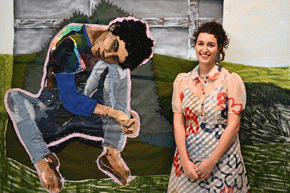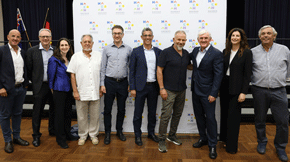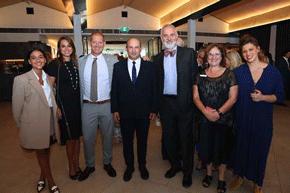Birthday greetings in parliament to the Sydney Jewish Museum
The Leader of the NSW Opposition has told the parliament of his participation at the Sydney Jewish Museum’s recent 25th anniversary.

Walt Secord at the Sydney Jewish Museum
Walt Secord who is also Shadow Minister for Health, Shadow Minister for the Arts and Shadow Minister for the North Coast delivered this adjournment speech:
On Sunday, as Deputy Leader of the Opposition and Deputy Chair of the Parliamentary Friends of Israel, I had the honour to speak alongside former Governor Marie Bashir and Sydney Deputy Lord Mayor Jess Miller at the Sydney Jewish Museum’s twenty-fifth anniversary celebration. We officially congratulated the museum administration, staff, benefactors and its more than 250 volunteers.
But most importantly, we recognised the Holocaust survivors, who inspire and educate visitors to the museum every year. Most of them comprise thousands of non-Jews with little or no knowledge of the Shoah.
Outside Israel, Australia’s Jewish community had the highest percentage of survivors. Between 1946 and 1954, more than 17,000 migrated to Australia.
I often say that whenever I attend Jewish functions I feel like I am at home, and this applies to the Sydney Jewish Museum. While I am not Jewish, my entire life has been connected to the Jewish community, both in Australia and in my birthplace, Canada.
As members will recall, my links to the Jewish community predate arriving in Australia and stretch back to an Indian reserve in Canada. I owe a special debt of gratitude to a wonderful Jewish man and mentor from my childhood, the late Gödel Silber, an Auschwitz-Birkeneau survivor.
Mr Silber always saw the best in people and supported anyone who asked to help. He profoundly shaped my views on racism, social justice, health and education. His influence followed me to Australia, where I worked as a journalist at the Australian Jewish News from 1988 to 1991.
I have also been a regular visitor to the Sydney Jewish Museum since it was officially opened on 18 November 1992—in fact, Mr Silber had steeped me in knowledge of the Jewish faith and culture so well that the editorial team of Australian Jewish News did not realise that I was not Jewish until about three weeks into the job.
During my time at the newspaper, I was fortunate to cover all aspects of Jewish communal activity, but most importantly I got to see Michael Bures’ early museum plans, Kylie Winkworth’s curatorial work and eventually the museum come to fruition.
At the time, I also remember interviewing Albert Halm, Eddie Jaku, Sol Schonberger, Mendel Gelberman, Olga Horak, Marika Weinberger, Pierre Lang and John Engleman. It was wonderful to see Ms Horak and Mr Jaku at the event. They are both in their nineties and they are very active.
The museum was founded due to the generosity of the late John Saunders and by members of the Australian Association of Jewish Holocaust Survivors.
Today it is one of the most beautiful and important Jewish museums in the world. I can compare it most favourably to other Jewish museums and institutions because I have been to a great many of them. I have been to Yad Vashem on three separate occasions. I have also visited the Memorial to the Murdered Jews of Europe in Berlin, the Jewish Museum Berlin, the United States Holocaust Memorial Museum in Washington; and great synagogues and smaller museums around the world including in Cairo, Toledo, Cordoba, Rome, Florence, Venice and Shanghai as part of my Jewish education.
Some people might regard these as unusual travel priorities for a non-Jewish person. People might regard some of my other travel itineraries as even more unusual, for many of them are informed by not only the study of Jewish genocides but genocides in general. In the past five years, I have been to Israel twice, stood at Auschwitz‑Birkenau in Poland on a freezing January day, walked through the ruins of the Armenian genocide in Turkey, visited the halls of the national Armenian Genocide Museum in Yerevan and travelled to Iraqi Kurdistan where Saddam Hussein murdered at least 5,000 Kurds in chemical attacks.
Here in Australia, I have also attended the infamous Myall Creek and Appin massacre commemorations as well as local ceremonies by the survivors of the Bosnian and Rwandan genocides.
Many colleagues and friends have asked me why. In fact, I heard a colleague once shout across the Chamber that during the parliamentary recess I should just go to the beach and read a book in the sun.
My answer is clear: I follow the study of genocides; I speak in Parliament about them; I travel to their locations; I support education about them because public knowledge of genocides is the best way to prevent them. My studies have shown me one thing: Any attempt to deny or cover up is the final stage of the process of genocide. Denial is the precursor to empower future perpetrators. And this is why museums like the Sydney Jewish Museum are so important.
I understand the museum has hosted more than 27,000 New South Wales school students. With the ageing of the Holocaust survivors and the loss of their testimony to the murder and atrocities of the Shoah, the work and activity of the museum is even more important, and that is why I support its work and its programs.
In conclusion, I wish the Sydney Jewish Museum a happy twenty-fifth birthday and I hope that I will be around to attend the fiftieth anniversary.
At the museum’s birthday celebrations, Professor Bashir described the museum as a “sacred place” and said it showed the resilience of the Jewish community and, particularly, Sydney’s Holocaust survivors.
I endorse that sentiment. I also cite the untiring efforts of Norman Seligman, Dr Gus Lehrer, Aviva Wolf and Roslyn Sugarman.
Furthermore, I acknowledged the recent pledge by four families—the Lehrer, Magid, Shand and Kamenev families—to donate $10 million to the Sydney Jewish Museum. That is truly outstanding and it will ensure the future of the wonderful institution.
I thank the House for its consideration.









